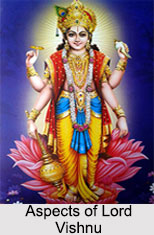 Aspects of Lord Vishnu, the Supreme Being or Paramatman are recognised as five by the Vaishnava tradition of Hinduism. All these are reflections of Vishnu in the qualities of Nature. Lord Vishnu is the highest God of Vaishnavism. The five aspects of Lord Vishnu are as follows:
Aspects of Lord Vishnu, the Supreme Being or Paramatman are recognised as five by the Vaishnava tradition of Hinduism. All these are reflections of Vishnu in the qualities of Nature. Lord Vishnu is the highest God of Vaishnavism. The five aspects of Lord Vishnu are as follows:
Para the transcendental Supreme Being beyond all.
Vyuhasthe emanations of God who reside in the higher planes.
Vibhavas, the incarnations of God who appear upon earth from time to time.
Antaryami, the immanent being who resides in all beings as a partner of the soul.
Arcavatara, the consecrated image of God made out of earthly material, which is worshipped by His devotees as God Himself.
Para: In his highest and supreme aspect, Lord Vishnu is Narayana himself known to his devotees variously as Paramatma, Parabrahma and Paramapita. He is the creator and lord of the Universe. The creator Brahma arises out of his navel, as he rests on the endless coils of the Adishesha in the waters of life, and begins the process of creation. He is the only pure (suddha), supreme (para) and absolute (ananta) principle (tattva).
Vyuha: The emanations or Vyuhas of Lord Vishnu are his projections. They exist in higher planes to perform different functions on a universal scale. The Vyuhas are said to be four in number, namely Vasudeva, Samkarshana, Pradyumna and Aniruddha. The ultimate source of all emanations is Para and each successive emanation emerges out of its preceding one. They are endowed with specific qualities and energies according to the tasks they perform.
Vibhava: In this aspect, God manifests himself upon earth as an incarnated being. He lives amidst people, undergoes the same experiences as the earthly beings, distinguishes himself by his deeds and words and interacts with them as one of their own kind. Because of ignorance and delusion, ordinary people cannot recognize his true identity. So they mistake him as one among themselves and fail to show respect.
Antaryami: According to Vaishnavism, God is not only transcendental but also immanent. He is hidden in the whole creation and in all the beings, enjoying the worlds and His own creation both as the subject and object of His own creation. Devotees of Lord Vishnu are urged to meditate upon this aspect of God to experience His beauty, grandeur and bliss. By knowing Him and experiencing Him one would attain the highest and transcendental self.
Arcavatara: The consecrated image is the fifth manifestation of God. While His other aspects are His creations, the Arcavatara is a creation of man. Devotees may create an Arcavatara (image) using the descriptions of God"s splendorous form available in the scriptures, install it in a temple or sacred place, consecrate it with mantras and worship it in a proper manner. He does not reside in the image, but becomes the image itself. The image may represent any aspect of God, His transcendental form, emanation, minor emanation, incarnation or minor incarnation.




















